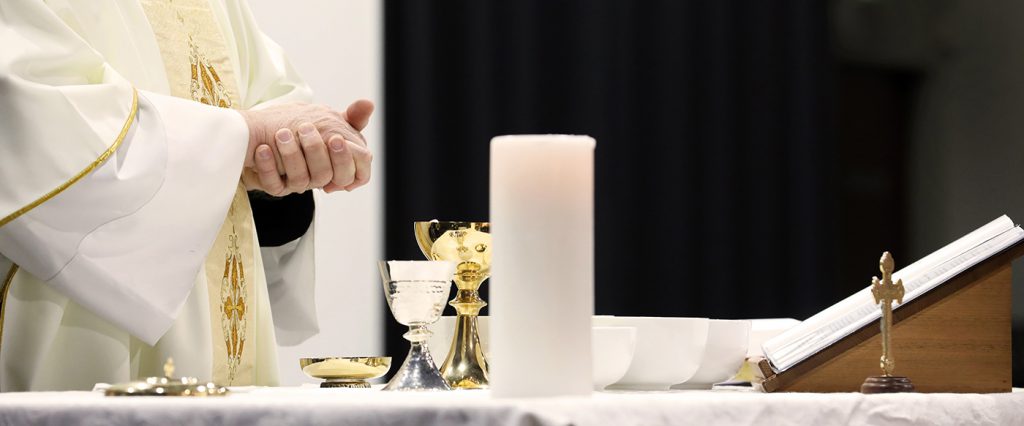“The liturgy is … a participation in Christ’s own prayer addressed to the Father in the Holy Spirit. In the liturgy, all Christian prayer finds its source and goal. Through the liturgy the inner man is rooted and grounded in ‘the great love with which [the Father] loved us’ in his beloved Son” (Catechism of the Catholic Church, No. 1073).
Liturgy, which includes but is not limited to the Holy Mass, is considered “formal” prayer because it follows a certain pattern, or rubric. Liturgical prayer is also “common” prayer, meant to be prayed by the community as a group. Even when circumstances require that liturgical prayer (such as the Liturgy of the Hours) is prayed alone, its established formula means that it is still being prayed in conjunction with anyone else in the world who is also praying. As we have learned during the coronavirus pandemic, a community does not always need to share space in order to share prayer, and we can find creative ways to pray liturgically without being in the same space — the exception being that we generally do not receive the Eucharist when we are not together.
The liturgy of the Church includes the Mass, the Liturgy of the Hours, and the celebrations of the sacraments. The Second Vatican Council stated the baptized who share a common faith “should come together to praise God in the midst of his Church, to take part in the Sacrifice and to eat the Lord’s Supper (Sacrosanctum Concilium, No. 10). As we pray our way through the liturgy, we unite ourselves to the whole Church.
The U.S. Conference of Catholic Bishops explains, “The word liturgy comes from a Greek term meaning ‘public work or work done on behalf of the people.’ A work, then, done by an individual or a group was a liturgy on behalf of the larger community. All the worshipers are expected to participate actively in each liturgy, for this is holy ‘work,’ not entertainment or a spectator event. Every liturgical celebration is an action of Christ the High Priest and of his Mystical Body, which is the Church. It therefore requires the participation of the People of God in the work of God.” Liturgical prayer is usually led by an ordained minister, who is configured uniquely to Christ.
Active participation in liturgy does not mean that everyone present has the same role. Bishops, priests and deacons — in addition to those who serve as lectors, altar servers, singers and musicians — participate in different ways from others. In different seasons of our lives, generally we participate differently. Even the person with limited mobility, who might need the priest to bring the Eucharist to their pew, can participate by listening to the readings, homily, and prayers, and by joining the singing of hymns and speaking the responses. Parents of young children may not be able to listen during Mass as well as they’d like, but their participation by helping their children learn to make the Sign of the Cross and continually redirecting their little ones’ attention to what is happening on the altar is still valuable and active participation. Through their participation, all present — no matter their role in the liturgy — exercise the royal priesthood of the baptized faithful.
Our liturgical celebrations should draw us closer to God as we pray as a community. The structure of the liturgy unites us as a Church in celebrating with the same prayers and Scripture readings no matter where in the world we are or what language we speak. The Scripture readings for Mass follow a cycle that repeats every three years for Sundays and solemnities, and every other year for daily Masses. The Church also uses a liturgical calendar to measure time according to certain seasons of feasting, penance, anticipation and expectation. With the liturgical calendar, we mark the celebration of holy days (the Proper of Saints) and holy seasons (the Proper of Time). Throughout the year in the liturgy, we celebrate the events of Jesus’ life as well as the feasts of Mary and the saints.
Liturgical prayer invites us to engage in praise, blessing and adoration, thanksgiving, petition and intercession as a community. Our communal prayer grows from the relationship with God we develop on our own in our devotional prayer. Coming together as a community to pray in a formal way, that relationship is nourished further, which then fuels our individual devotional prayer.
Barb Szyszkiewicz, a Secular Franciscan, is editor at CatholicMom.com and author of “The Handy Little Guide to Prayer” (OSV, $5.95). Read more from the prayer series here.

